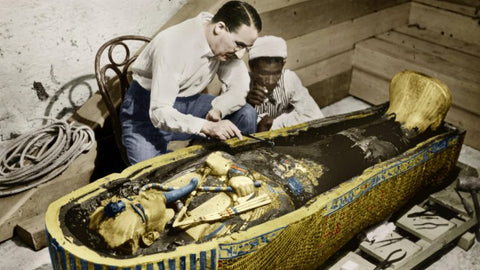A Stitch in Time: Early Discoveries
The excavation of ancient Egyptian tombs has revealed not just relics of a bygone era, but also the astonishingly preserved embroidered textiles that adorned the lives and afterlives of the Egyptians.
Early Glimpses into the Past
One of the earliest significant discoveries was in the tombs of the Old Kingdom, where archaeologists uncovered fragments of linen with delicate embroidery, offering insight into the craftsmanship and aesthetic sensibilities of that era.
The Tomb of Tutankhamun: A Textile Treasure Trove
 |
In this historic photograph, Howard Carter meticulously inspects the ornate sarcophagus of Tutankhamun, revealing the pharaoh's embroidered vestments—a tapestry of ancient Egypt's opulence, preserved for millennia. |
The discovery of Tutankhamun’s tomb in 1922 by Howard Carter brought to light a wealth of embroidered items. From robes adorned with thousands of sequins and beads to intricately stitched shawls, each piece provided a deeper understanding of the role of embroidery in royal and ceremonial attire.
Preservation and Study
The preservation of these textiles has been a testament to the ancient Egyptians' mastery of embroidery and fabric care. Researchers have meticulously studied these artifacts, piecing together the evolution of embroidery techniques and styles over centuries.
A Gateway to Ancient Artistry
These initial findings served as a gateway to understanding the broader scope of textile art in ancient Egypt. They revealed the social and cultural importance of embroidery, showcasing a civilization that valued beauty, precision, and symbolism in every stitch.
